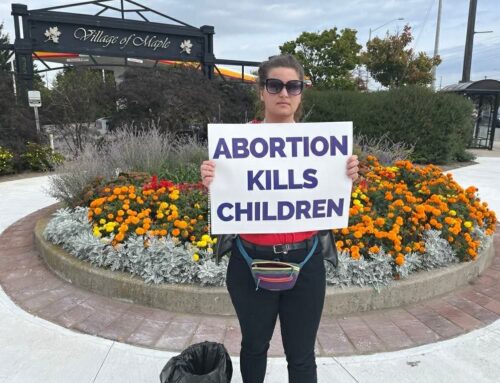Paul Tuns
I want to bring to your attention three articles written about euthanasia over the last few days that are all very important.
The first is the always pertinent Wesley Smith, at NRO, with an article titled, “Alzheimer’s Breakthrough and the False Compassion of Assisted Suicide.” Smith notes:
Alzheimer’s and other dementia patients are now in the cross hairs of the euthanasia movement. In the Netherlands, Belgium, and soon in Canada, people diagnosed with Alzheimer’s can order themselves killed once they become incompetent. Or they can receive euthanasia before that time.
Meanwhile, our domestic assisted-suicide zealots teach elderly people how to commit suicide by self-starvation, with the agony of such a course palliated by a doctor — known in euthanasia parlance as VSED (voluntary stop eating and drinking). There are even legal moves afoot to allow advance directives to be written legally ordering caregivers to starve dementia patients death — even if they willingly eat! Nevada has passed such a law.
If new treatments do materialize, how many dementia patients will have died by their own or others’ hands who might have lived if they had continued on until new treatments came on line? I shudder to think.
Smith says that at the height of the AIDS epidemic, he has no doubt that an not insignificant number of AIDS patients had hastened deaths by medical means, but that after drugs that ensured people with virus could live vibrant lives were developed, AIDS “was suddenly redefined from a terminal to a chronic condition,” and the assisted-suicides of AIDS patients became less commonplace. It is is Smith’s hope — and ours, too — that with new FDA-approved drugs that appear to significantly retard cognitive decline, that the hastened deaths of those with dementia will be strongly curtailed as they, too, are given new life through medical advances. Physician-assisted death is not medical progress and its normalization and legalization must be reversed.
Alex Schadenberg, executive director of the Euthanasia Prevention Coalition and a member of the editorial advisory board of this paper, notes that a report yesterday stating that euthanasia deaths had increased 17 per cent in 2020 compared to the previous year is wrong. The actual increase is 35 per cent: 7595 in 2020, up from 5631 in 2019. Schadenberg notes, “7595 reported MAiD deaths represents approximately 2.5% of all deaths” in 2020. In other words, euthanasia is becoming more commonplace — accepted and normalized, after being legalized.
Which brings us to Margaret Somerville’s excellent essay at MercatorNet: “Can We Find a Vaccine for the Euthanasia Virus Pandemic?” Somerville begins her piece:
The Covid-19 virus pandemic is a threat to our physical and mental health and wellbeing, as both individuals and societies.
The euthanasia “virus” pandemic is, likewise, a threat to our physical and mental health and wellbeing, as both individuals and societies. Most seriously, it is a threat to our “human spirit”, the intangible, invisible, immeasurable reality that all of us need to find meaning in life and to make life worth living, that deeply intuitive sense of relatedness or connectedness to all life, especially other people. The “human spirit” does not require a belief in the supernatural. Everyone has a “human spirit”, whether or not they are religious.
Like the Covid-19 virus, euthanasia seems to be contagious, at least in post-modern, Western democracies. (Note: I use the word euthanasia to include medically assisted suicide.) Jurisdiction after jurisdiction has considered or is considering its legalization, although some have expressly rejected it. From one perspective, this spread is not surprising, because we know that suicide is contagious. In fact, general suicide rates — that is, exclusive of euthanasia — have risen in most and possibly all jurisdictions, which have legalised euthanasia.
Somerville examines the reason behind the widespread movement legalizing medicalized killing: control and choice. I think her comments about the psychological desire for control is worth highlighting:
In the context of euthanasia, control translates to taking control of death. We cannot avoid death, but euthanasia allows a person to get it before it gets them. This eliminates uncertainty about the time, place and manner of death. It is psychologically difficult to live with uncertainty about outcomes that we dread, including because we do not know which psychological coping mechanisms we need to employ to deal with the fear we experience.
Taking control is what social psychologists call a “terror-reduction” or “terror management” device. Intense fear of death can be linked to a fear of mystery, the latter of which evokes profound free-floating anxiety. People who experience this can deal with their fear and anxiety by converting the mystery to a problem and seeking a technological solution to the problem. The mystery of death becomes the problem of death and the technological solution is a lethal injection – euthanasia.
Somerville, Professor of Bioethics at the University of Notre Dame Australia School of Medicine, notes that euthanasia advocates often trot out sad stories to make their case, whereas the argument against euthanasia is more “complex.” Furthermore, the sad stories of the abuse of euthanasia regimes are ignored or belittled as aberrations, rather than serious concerns about how euthanasia is actually practiced. Somerville argues that if we are to have euthanasia — and she, like us, would rather not have legal euthanasia and physician-assisted suicide — “we must take the medical cloak off it” and create a new profession for carrying it out. She argues that most medicalized killing is euthanasia and not assisted-suicide because, “euthanasia masquerades as medical treatment and we trust doctors and assume they are acting ethically and only doing good.” Somerville says to have an honest policy discussion about the nature of euthanasia, we must remove it from the hands medical professionals and view it attached to some good larger than personal autonomy: the value of human life to both the individual and society. Or, at the very least, “we need a new iteration of the old virtue of prudence, which can be re-named ‘wise ethical restraint’.”
Thus far, there has been very little restraint in the governance of euthanasia, with every legalization and set of limits placed on it soon giving way to an expanded definition of eligibility for a medicalized death. As this paper noted two decades ago, one person’s safeguards is another person’s unjust discrimination, a denial of an allegedly compassionate death. (As we have also noted in a 2016 editorial, “There are no regulations or restrictions that can make euthanasia and assisted-suicide licit. There are no safeguards that can be enacted to effectively protect the vulnerable.”) Whatever guardrails are initially erected to protect some group of vulnerable people will eventually be cast aside.
Somerville’s is a long essay but worth the read. The euthanasia mentality is a pandemic that puts many people’s lives in jeopardy, hastening death in a way that does not speak well of a supposedly caring society.




